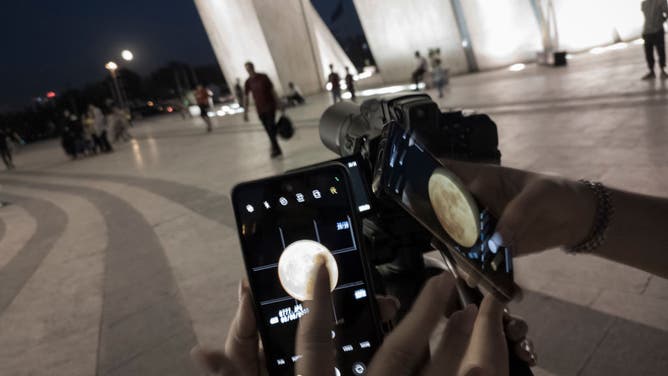How to photograph the Moon with your phone
Try photographing the Moon when there is still some sunlight left and check your camera settings or use a photography app to have more control of your ISO and shutter speed.
A beginner's guide to photographing the night sky with your camera phone
From meteor showers to full moons, here are some tips you can use to capture stunning photos of the night sky with your camera phone.
When a full Moon is in the night sky, it's tempting to want to capture Earth's only natural satellite, but if you whip out your smartphone and take a quick shot, the Moon might look more like a grainy smudge in the sky.
With a few tricks to improve your cell phone photography skills, you can capture the glowing Moon in all its glory.
Time your moonshot

FILE PHOTO: A person walks along Manly beach as a partial eclipse of the Moon begins on November 08, 2022 in Sydney, Australia. (Photo by Brook Mitchell/Getty Images)
(Getty Images)
The Moon can be hard to photograph with a phone because it is a bright object surrounded by a dark sky, which can cause your iPhone or smartphone to overexpose the Moon as it tries to capture the black background. One way to help this overexposure is by reducing the darkness around the Moon simply by taking a photo when there is still some sunlight lighting the sky.
HOW TO PHOTOGRAPH A METEOR SHOWER WITH YOUR PHONE
A full Moon or even a full Supermoon is a good chance to photograph the Moon. The Moon can appear full in the days before and after the actual full Moon.
Professional photographer Sigma Sreedharan in Seattle recommends trying to photograph the Moon after sunset the evening before the full Moon. The ambient twilight will help reduce the contrast between the Moon and the sky.
Check your settings

FILE PHOTO: A person takes a photo of the full Moon with a cell phone in Istanbul. (Photo by Onur Dogman/SOPA Images/LightRocket via Getty Images)
(Getty Images)
Another thing that can help with overexposure is a zoom lens. Newer smartphones, like the iPhone, have a zoom telephoto lens. This will help reduce the sky around the Moon and focus more on your object.
To help prevent overexposing the Moon, use a lower ISO. A lower ISO means lower light sensitivity.
Because the Moon is a moving target, even if it doesn't look like it to the naked eye, use a faster shutter speed.
iPhone Night Mode allows you to adjust the exposure time, so you'll want to use the faster exposure.
MOON SHOT: 7 TIPS ON HOW TO SHOOT THE MOON… WITH A CAMERA
Even older smartphones have exposure settings you can work with.
Sreedharan recommends a shutter speed of over 1/20th per second to photograph the Moon.
Play around with your shot and your settings. If it's a wide shot with more in the foreground, or you are just trying to photograph the standalone Moon, you will have different settings.
Use an app
Many photography apps offer more flexibility if your phone can't adjust exposure and shutter speed.
Most popular apps require a small payment between $2.99 to $25 a year to unleash the full potential and settings.
The NightCap Camera app is designed with astrophotography and low-light situations in mind.
For $2.99, the app allows you to create long exposures and adjust the ISO and F stop. It even has settings to capture shooting stars, the Moon and human-made objects in space, including the International Space Station.
Grab a tripod and binoculars

FILE PHOTO: Photographers check an image of the moon, known as the Blue Moon, on their cell phones under the Azadi (freedom) monument in western Tehran August 30, 2023. (Photo by Morteza Nikoubazl/NurPhoto via Getty Images)
(Getty Images)
If your Moon photos come out blurry. Try adding a simple tripod to your setup.
B&H Photo sells a variety of inexpensive smartphone tripods that can stand alone or use grip mounts to attach the stand to a car, a fence, your lawn chair or anything that is ideally not moving.
Most smartphones have wide lenses, making the Moon appear even smaller. You can put your phone lens up to a binocular lens or even a small telescope; the difference is immediate. Getting the camera and lens to stay positioned might take some finesse, but there are also tools to help with that.
